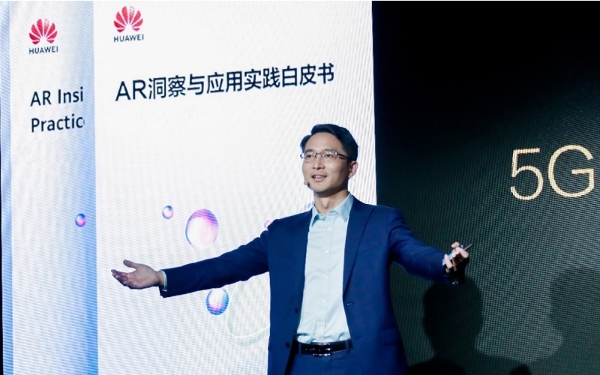Huawei projects robust growth with 5G augmented reality
- By Guo Yiming
 0 Comment(s)
0 Comment(s) Print
Print E-mail China.org.cn, June 18, 2021
E-mail China.org.cn, June 18, 2021
China's tech giant Huawei and third-party data predict that the augmented reality (AR) market will be worth US$300 billion by 2025, a senior executive of Huawei said on Thursday in Shenzhen, southern China's Guangdong province.

Bob Cai, chief marketing officer (CMO) of Huawei Carrier Business Group, made the statement during Huawei's Better World Summit (BWS) in China's southern city, calling for concerted efforts across the industry to deliver a prosperous 5G+AR value chain.
AR involves the projection of digital visual elements into a person's real-world surrounding.
According to Cai, "AR will first see massive adoption in five prioritized industries: education, social networking, shopping, traveling & navigation, and gaming." He added, "The technology can truly enable the convergence of the physical and digital worlds, making dreams a reality."
The integration of 5G and AR is supporting global carriers and industry partners extending their business boundaries and driving new growth, said Eric Zhao, vice president of Huawei CNBG Marketing. "The 5G+AR ecosystem is maturing, making education more impressive, entertainment more fascinating, communication more efficient, and people's lives more convenient."
5G connections feature large bandwidth, low latency and high mobility, noted Kevin Xu, vice president of the Huawei CNBG Marketing Demand Program. "With the higher availability of consumer AR trending and the wider coverage of 5G networks, we believe that the 5G+AR combination will unleash greater potential for the market."
During the summit, Cai shared case studies of Huawei employing AR. Due to COVID-19, customers from across the globe are unable to visit Huawei in person, so Huawei makes use of AR to demonstrate its leading products and solutions online, making communication far more efficient. The company also uses AR to achieve the quick delivery of 5G base stations, greatly boosting delivery efficiency.
He also introduced the Huawei AR Engine, the company's AR development platform oriented toward mobile devices. With Huawei AR Engine, developers need to write only 10 lines of code to create AR effects, hugely increasing the efficiency of AR application development, he noted.
During the event, Huawei released a white paper on AR's development and application practice, which profiles the industry from the perspective of devices, applications and network, calling for concerted efforts across sectors to create a prosperous 5G+AR ecosystem.
AR is not only about the device, the content, or the network. It is about combining the capabilities of all three to create a compelling offering, the white paper observed. It went on suggesting that a partnership approach, establishing unified standards and mechanisms, and bringing together expertise across all of the different areas, will create a prosperous AR industry.
"AR and 5G are combining at the right time," said Cai. "5G switches on AR and AR lights up 5G."
This year's BWS, based on the theme "5G+AR: Enriching our Lives," has drawn a number of high-profile guests including He Chengjian, director of Shenzhen Communication Management Bureau, and David MacQueen, executive director of Strategy Analytics, who shared the latest AR use cases and their thoughts about AR's future trends.






Go to Forum >>0 Comment(s)